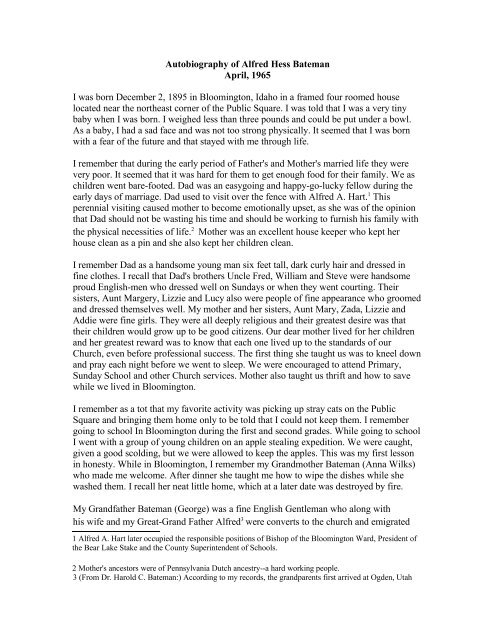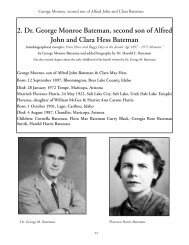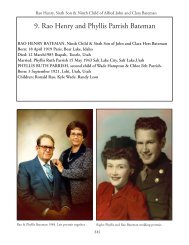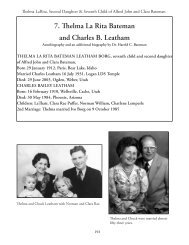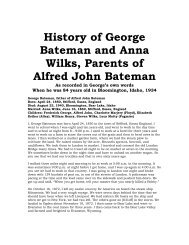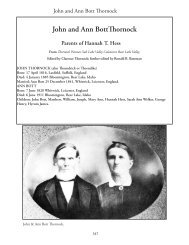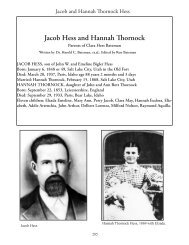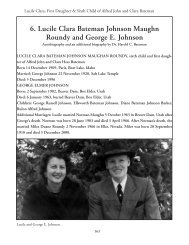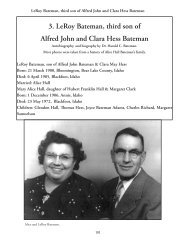Autobiography of Alfred Hess Bateman April, 1965 ... - Bateman Family
Autobiography of Alfred Hess Bateman April, 1965 ... - Bateman Family
Autobiography of Alfred Hess Bateman April, 1965 ... - Bateman Family
- No tags were found...
Create successful ePaper yourself
Turn your PDF publications into a flip-book with our unique Google optimized e-Paper software.
<strong>Autobiography</strong> <strong>of</strong> <strong>Alfred</strong> <strong>Hess</strong> <strong>Bateman</strong><strong>April</strong>, <strong>1965</strong>I was born December 2, 1895 in Bloomington, Idaho in a framed four roomed houselocated near the northeast corner <strong>of</strong> the Public Square. I was told that I was a very tinybaby when I was born. I weighed less than three pounds and could be put under a bowl.As a baby, I had a sad face and was not too strong physically. It seemed that I was bornwith a fear <strong>of</strong> the future and that stayed with me through life.I remember that during the early period <strong>of</strong> Father's and Mother's married life they werevery poor. It seemed that it was hard for them to get enough food for their family. We aschildren went bare-footed. Dad was an easygoing and happy-go-lucky fellow during theearly days <strong>of</strong> marriage. Dad used to visit over the fence with <strong>Alfred</strong> A. Hart. 1 Thisperennial visiting caused mother to become emotionally upset, as she was <strong>of</strong> the opinionthat Dad should not be wasting his time and should be working to furnish his family withthe physical necessities <strong>of</strong> life. 2 Mother was an excellent house keeper who kept herhouse clean as a pin and she also kept her children clean.I remember Dad as a handsome young man six feet tall, dark curly hair and dressed infine clothes. I recall that Dad's brothers Uncle Fred, William and Steve were handsomeproud English-men who dressed well on Sundays or when they went courting. Theirsisters, Aunt Margery, Lizzie and Lucy also were people <strong>of</strong> fine appearance who groomedand dressed themselves well. My mother and her sisters, Aunt Mary, Zada, Lizzie andAddie were fine girls. They were all deeply religious and their greatest desire was thattheir children would grow up to be good citizens. Our dear mother lived for her childrenand her greatest reward was to know that each one lived up to the standards <strong>of</strong> ourChurch, even before pr<strong>of</strong>essional success. The first thing she taught us was to kneel downand pray each night before we went to sleep. We were encouraged to attend Primary,Sunday School and other Church services. Mother also taught us thrift and how to savewhile we lived in Bloomington.I remember as a tot that my favorite activity was picking up stray cats on the PublicSquare and bringing them home only to be told that I could not keep them. I remembergoing to school In Bloomington during the first and second grades. While going to schoolI went with a group <strong>of</strong> young children on an apple stealing expedition. We were caught,given a good scolding, but we were allowed to keep the apples. This was my first lessonin honesty. While in Bloomington, I remember my Grandmother <strong>Bateman</strong> (Anna Wilks)who made me welcome. After dinner she taught me how to wipe the dishes while shewashed them. I recall her neat little home, which at a later date was destroyed by fire.My Grandfather <strong>Bateman</strong> (George) was a fine English Gentleman who along withhis wife and my Great-Grand Father <strong>Alfred</strong> 3 were converts to the church and emigrated1 <strong>Alfred</strong> A. Hart later occupied the responsible positions <strong>of</strong> Bishop <strong>of</strong> the Bloomington Ward, President <strong>of</strong>the Bear Lake Stake and the County Superintendent <strong>of</strong> Schools.2 Mother's ancestors were <strong>of</strong> Pennsylvania Dutch ancestry--a hard working people.3 (From Dr. Harold C. <strong>Bateman</strong>:) According to my records, the grandparents first arrived at Ogden, Utah
first to Evanston, Wyoming and later moved to Bloomington. My Grandfather was ablacksmith and also freighted between Bear Lake County and Ogden. 4 On one occasionhe was held up by bandits who relieved him <strong>of</strong> his entire load which consisted <strong>of</strong> dressedbeef. While we lived in Bloomington, George M. (Monnie) was also born in the littleframe house. It was the custom those days to let the children grow long braids. It wasduring this time that George had long brown braids in his hair that I cut them all <strong>of</strong>f andput them in the trash can. My mother was very upset and I received a good switching. Onone occasion we went to Sacrament Meeting in Bloomington, Dad was asked to open themeeting with prayer. I recall that poor Dad went upon the stand, his face turned white andhe could not say a word so he sat down. 5 I realize now that I inherited some <strong>of</strong> his fear.While we lived in Bloomington father bought about a hundred acres <strong>of</strong> wild hay land East<strong>of</strong> Paris, Idaho in the low lands. During the year 1905 father purchased 16 acres <strong>of</strong> alfalfaland which was located about one mile south <strong>of</strong> Paris. We lived here for several years.We had fine facilities for ice skating. We would skate for miles and ride a sleigh downthe mountain sides. I recall that the three <strong>of</strong> us, George M., LeRoy and myself, rode awhite horse daily to the public schools in Paris. Our Mother's parents , Jacob and Hannah(Thornock) <strong>Hess</strong> lived a short distance North on the Highway. My Grandfather <strong>Hess</strong> wasa hard working farmer. He maintained an excellent dairy heand efficiently operated amedium sized farm. Grandfather <strong>Hess</strong> was the oldest <strong>of</strong> 64 children. He was the son <strong>of</strong>John W. <strong>Hess</strong>, a member <strong>of</strong> the original Mormon Battalion, and a Prominent UtahPioneer who, with his seven wives, was prosperous and helped build the thrivingcommunity <strong>of</strong> Farmington, Utah. John W. held church <strong>of</strong>fices <strong>of</strong> Bishop and StakePresident for many years.While we lived on the farm, Milfoand Acquilla <strong>Hess</strong> were our playmates. They were ouruncles but were about the same age as George M. and myself. Our yellow dog, Toby, diedon the farm when he was 12 years old. He was a faithful companion. I also remember thatI had some beautiful white rabbits and raised ducks. My riding horse was named Kit. Ialso owned a mare by the name <strong>of</strong> Nell.Being country boys, the city boys had a dislike for us and would run us out <strong>of</strong> town rightafter school was dismissed. We would run from them like deer.One boy, a tall Dutchman by the name <strong>of</strong> Earnest Jausu, was the leader <strong>of</strong> this mob. Ilater had the satisfaction in giving him a good whipping before a large crowd. I laterdefeated the town bully, Cyiel Sutton, in a bloody fight. After these fights I was able topursue a more happy and peaceful life without being constantly attacked by townhoodlums. This did not occur until after we had lived in Paris for several years. Dad hadmade me a present <strong>of</strong> a pair <strong>of</strong> boxing gloves. I secretly trained for a couple <strong>of</strong> yearswhere they were met by relatives (Jarvises) and then were taken to Bloomington, Idaho. Finding no workthere, they were compelled to move to Almy, Uinta County, Wyoming just a mile north <strong>of</strong> Evanston wherethey found work in the Union Pacific coal mines. Father was born in Almy.4 (Note from Dr. Harold C. <strong>Bateman</strong>:) Also Grandfather freighted between Evanston, Wyoming and BearLake rather than Ogden.5 My Grandfather <strong>Bateman</strong> was Counselor to Bishop Findley.
which finally paid <strong>of</strong>f.After we moved into Paris, Dad purchased a home east <strong>of</strong> the highway across the streetfrom Bishop EdwaSutton. The W. W. Richards family lived immediately to the North.Mr. Richards was first Counselor to Joseph R. Shepherd, President <strong>of</strong> the Bear LakeStake. Russ Richards, son <strong>of</strong> W. W. Richards, became a close and almost constantcompanion during the time I lived in Paris. O’Neal Rich became a close companion toGeorge M., Spencer Rich a companion to Roy and Reed Rich was Harold's companion.George M. and Harold became Doctors <strong>of</strong> Philosophy and the three Rich brothers becamemedical doctors. Roy chose Railroading as his vocation. 6After a year or two Dad purchased a home with acreage up on Canyon Road. The ParisCreek meandered through a luxuriant meadow grass pasture. Another branch <strong>of</strong> thestream also flowed through the corral to supply the livestock with all the water they coulddrink. There was a large barn on the place. By this time Father had acuminated severalfine draft and buggy horses. He would stay out in the barn for hours caring for thosehorses, feeding them hay and grain and grooming and currying them. He also kept hisharnesses oiled and cleaned up. Tassels and rosettes were part <strong>of</strong> the harnesses. He lovedto drive fractions teams in a white topped buggy or a black topped surrey. Many a timewe went in this fashion to the Bear Lake to have a picnic and to spend the day swimmingand boating.On canyon road we lived in the old house for a while but Dad built a new house. The bigfront window and the door to the Parlor were made <strong>of</strong> plate glass. Mother was very proud<strong>of</strong> the house. We lived in the kitchen and on Sundays a fire was made in the Parlor.Mother had the Idea that she wanted me to be a pianist, so they bought a nice piano. Idrove Tillie Price to St. Charles in our little surrey which was pulled by a white horse.This was the way that I paid for my lessons. I never did develop into a finished pianist.Harold was born into the family at the O’Neil home. He was a distinguished lookingyoung man. He was more like a prince, so I called him Prince Austie Bamclaim <strong>of</strong> theAustrian Throne. My favorite little baby brother was Russell. He always sat near the frontwindow and came running and put his arms around my neck. His sudden death broughtdeep sorrow to us all. Our own son Russell was like my little bother Russell in beingaffectionate.Dad had become a successful horseman. He sold a number <strong>of</strong> stallions in Bear LakeCounty and in Star Valley. He was in partnership with Gideon Alvo<strong>of</strong> Logan, Utah. The<strong>of</strong>fspring <strong>of</strong> these fine horses were sold by Dad and H.P. Zlmmermann in Riverside,California for work in the orange groves. He also bought horses for the United StatesCavalry. He was making a better living than the average. After gasoline automobilesbecame available he was one <strong>of</strong> the first to purchase a Ford car.While going to elementary and highschool at Fielding Academy. I milked ten cows night6 I remember the affection Dad had for his sons. After he began to make money in the fall <strong>of</strong> the year, hewould buy all <strong>of</strong> us a fine suit. I remember his desire to wear fine Stetson hats.
and morning. George M. fed and cared for about as many horses. We hauled Yellow pinewood from the mountains and sawed and split it up for fire wood during the winter.During the summer we worked on our farm. We had Saturday afternoon <strong>of</strong>f so we wouldgo to the old swimming hole for a plunge. After the swim we would fish for trout andfresh water chubs. I spent one summer working for Sim Rich. I also spent a summerworking for Uncle Joseph Lindford in Afton, Wyoming. The schedule for the day was tostart milking, by hand, thirty cows at 4:30 AM. By 6:30 or 7 AM. we began to work inthe field for the hay harvest and the field work was completed by sundown and theevenings milking was usually completed by 11 P.M. I <strong>of</strong>fered my services for $1.00 a dayand board and room. When I left, Uncle Joe, gave me $1.25 and board. A dollar wasworth a lot In those days.Lucille and Thelma, two pretty sisters, came along. I used to tease Lucille. I posed asUncle Alexander. We had fun. Our youthful days were the best. Othel and Rayo cameafter I left home.In High School I took part in the Operetta and Oratorical contests. During two summersImmediately preceding World War 1, I worked on the Hydraulic Dredge one the Northend <strong>of</strong> Bear Lake. My title was “flunky” assisting the cook. I also worked as a rigger tomove heavy pieces <strong>of</strong> machinery. George M. was working as an assistant electrician. Itwas during this period that I accompanied Lyman Rich to Salt Lake City and joined the145 th FA Utah National Guard on August 2, 1917. We camped for a month on the sameground where the National guard armory 7 now is located. Here we received preliminarytraining. We were transported by train to Camp Kerney near San Diego, California, forbasic training. In Camp Kerney we usually had the week ends <strong>of</strong>f. I would usually go intoSan Diego and attended a dance on Saturday night and attend Sunday Service. AbrahamTueller who was stationed with the 21 st Infantry was the Branch chorister. I enjoyed mytrips to LaJolla, California where I was adopted into the Seymour family as “almost ason.” The family consisted <strong>of</strong> Grayce Seymore, her Mother and her brother and a sister. Iwas invited to stay at the house. They arranged picnics to Torrey Pines and on the beachat the cove where we also went swimming. I was a member for the 145 th Field ArtilleryBand. We gave concerts in San Diego and on the base. The 145 th was part <strong>of</strong> the 65 thBrigade, 40 th Sunshine Division. Brigadier General Richard R. Young was commandingGeneral <strong>of</strong> the 65 th Field Artillery and Colonel William C. Webb was our Regimentalcommander. Lieutenant Clarence J. Hawkins was our Band Director. One <strong>of</strong> the mostmemorable occasions was an invitation to the home <strong>of</strong> Madame Schuman Heink whichwas located at Coronodo. Mrs Schuman Heink, who was a world renowned singer, was afriend <strong>of</strong> Clarence Hawkins. He had taken music lessons from her at the BostonConservatory School <strong>of</strong> Music. She had four sons in the German Army and four sons inthe U.S. Army.During August <strong>of</strong> 1918 we left Camp Kearney for New York by train. On our way westopped in Tucson, Arizona and took a swim. I remember the shacks that the Negroeslived in on our way East. We were first stationed at Camp Upton, New York on LongIsland. After staying at Camp Upton for about two weeks we embarked on a War ship7 Armory is located at about 8 th East and 15 th South in Salt Lake City.
sailing out <strong>of</strong> Hoboken, New York bound for England. On the voyage overseas we sangmany songs such as “Good Bye Broadway Hello France”, “Pretty Katie”, “Keep YourShades Down Mary Ann”!'. We finally arrived at Liverpool. England. After descendingon land, the 145 th Field Artillery Band played the Stars and Strips Forever. This gave us athrill. After staying at Knotty Ash Barracks in Liverpool we crossed the Channel toLaHarve, France. From their we traveled South and were quartered in a little town nearBordeaux, France.Women washed their clothes in the streams. They pressed grapes with their feet to makewine. Later we were assigned to Camp De Sue, a flu infected camp, located 20 milesfrom Bordeaux. This was a training camp for regiments who used the French 75 artillerypiece. Due to infestation <strong>of</strong> flees we lived out in pup tents. During the winter manysoldiers died from the flu. After the Armistice was signed we sailed for New York Cityarriving in January. On January 28, 1919 we were mustered out <strong>of</strong> the Army.I went home for a short time and then went to Salt Lake City and got a job cleaningcoaches for the Union Pacific Railroad. My brother LeRoy joined me and we rented aroom together and worked together. We had a room just North <strong>of</strong> the Temple. In the fall Iquite and attended Utah State Agricultural College at Logan, Utah. During the summertime I inspected fields <strong>of</strong> sugar beets for nematode. After graduating with a BachelorDegree in Agriculture I continued my employment with the Amalgamated SugarCompany and finished a Masters Degree with a theses entitled “Field Studies <strong>of</strong> the sugarbeet Nematode”.It was while I was in a field looking for Sugar Beet Nematodes that I met my future wife,Idella Van Orden. On March 14, 1923 I was married to Idella in the Logan Temple. Ipurchased a home in Logan near the Fair Grounds on 3 rd West. My wife was a great helpwith the calculations for my research for my Masters Degree. She also was an excellenthousekeeper and cook. She was thrifty and did a fine job <strong>of</strong> canning meat, fruit andvegetables. I had worked for the Sugar Beet Company for two summers and two fullyears. I graduated from Utah State College with a Master <strong>of</strong> Arts degree. During May <strong>of</strong>1924 I was <strong>of</strong>fered the position <strong>of</strong> Vocational Agriculture Instructor at Midway HighSchool, Lewisville, Idaho. I purchased a new Model T Ford car for $645.00 and drove thecar to my new job during the last part <strong>of</strong> June. Idella remained in Logan for a while untilour first child, <strong>Alfred</strong> VanOrden <strong>Bateman</strong> was born on August 11, 1924 in the CacheValley Hospital. 8 After Idella and my son, whom we called Orden, joined me we lived inthe L. A. Thomas home and later in the William Walker home. While in the LewisvilleWard I taught in the Sunday School and Mutual. Our next child who was Helen Grayce 9who was born in the Cache Valley Hospital, Logan, Utah <strong>April</strong> 3, 1926. H. K. Merrillwas the Doctor in charge.We moved to Ashton, Idaho where I taught school from July 1, 1926 to July 1, 1929.While in Ashton I was ordained a Seventy on September 2, 1927 and also set apart as one<strong>of</strong> the Seven Presidents. I was also the Stake Superintendent <strong>of</strong> Religion Classes <strong>of</strong> the8 Heber K. Merrill, M.D. was the Doctor who delivered our first child.9 The spelling <strong>of</strong> Grayce was after Grayce Seymore <strong>of</strong> LaJolIa, Ca.
Yellowstone Stake, with Idella as secretary, and I was also the Second Councilor in theAshton Ward Bishopric. I was ordained a High Priest January 13, 1929. Believe it or not Iwas also a Scoutmaster.While in Ashton, many exhibits <strong>of</strong> Ashton produce such as potatoes, grains etc. wereprepared, under my direction, for competition. Ashton was awarded 1st place and manyribbons for four years at the Idaho Spud Show held annual at Shelly Idaho. One year thehighschool was awarded 15 cups in competition. Much credit was due to my wife Idellawho helped me and backed me 100 percent in these activities. I also conducted eveningclasses in Seed Potato production. During Christmas <strong>of</strong> 1927 the Ashton Seed Growerspresented me with a 21 jeweled Hamilton gold watch. The Agriculture students alsopresented me with a nice desk set.From July 1, 1929 to July 1, 1938 we lived in Idaho Falls where I taught as Instructor <strong>of</strong>Vocational Agriculture. Our final child, Russell Rulon <strong>Bateman</strong>, was born on February11, 1930 in the Idaho Falls Hospital. 10 Our three children, while they were growing up,never gave us any worry. They were a pride and joy. They attended Primary, Mutual,Sunday School, etc. Perhaps we did not give them the full attention that they deserved. Itseemed that I was under much stress and pressure on my job. A teacher was not sure thathe would have A job the next year as they were hired from year to year.While there I served as Superintendent <strong>of</strong> the 3 rd Ward Sunday School <strong>of</strong> the Idaho FallsStake <strong>of</strong> Zion. I was also First Counselor in the Lincoln Ward Bishopric. There were anumber <strong>of</strong> highlights while we were in Idaho Falls. We won first place and second placeat the Eastern Idaho Fair for school and community exhibits. One boy, Clude Johnson,was elected to the American Farmer Degree. Our Livestock Fair held in Idaho Fallsannually brought favorable attention. I taught a number <strong>of</strong> successful classes for adultsand out <strong>of</strong> school future farmers.From July 24 to November 30, 1938 I worked a assistant Supervisor to the Farm HomeAdministration In Logan and Garland, Utah. On December 1, 1938 I accepted a positionas Assistant Agronomist at Morgan, Utah with the Soil Conservation Service. In the Fall<strong>of</strong> 1939 we moved to St. George. While in St. George and in Cedar City I worked as anAssistant District Conservationist, District Conservationist, Soil Conservationist andArea Agronomist. My job was mainly farm and ranch Planning.While in St.George I was a member <strong>of</strong> the Rotary Club serving as Secretary for a shorttime. I served as Instructor and Group Leader in the High Priests Group. I served asinstructor in Cedar City Third Ward High Priest Group. I served the SCS headquarters inCedar City for about three years from the spring <strong>of</strong> 1942 to the summer <strong>of</strong> 1945. IWorked out <strong>of</strong> Cedar City in 13 Soil Conservation Districts.Orden joined the Army after graduating from Cedar City High School during World WarII. He went through a number <strong>of</strong> battles but returned safe.10 H. Ray Hatch M.D. was the doctor In charge.
It was in 1949 That we purchased the Liberty Drug Store 11 in St. George. This venturewas due to my wife's ambitious desire to go into business. In the management <strong>of</strong> the storeshe has applied herself wholeheartedly which has resulted in the building up a prosperousbusiness. It is now located in a new building south <strong>of</strong> Dick's Cafe and is considered one<strong>of</strong> the most up to date drug stores for its size in Utah or in the U.S.A. for that matter. Dueto allergies and other things that cause sickness she has not been able to take an activeroll in the business that she previously took. So she is now living in Henderson, Nevadawhere she purchased our home for retirement and old age. Orden is taking theresponsibility for most <strong>of</strong> the active management while Idella is handling thebookkeeping.While we lived in St. George our three children got married. Orden married Afton Jones<strong>of</strong> Cedar City and later completed his studies at the U <strong>of</strong> U School <strong>of</strong> Pharmacy in thefirst graduating class. They have two girls and a boy.Helen Grayce married Glen Kenworthy <strong>of</strong> St. George. They live in Henderson, Nevadaand have four girls and two boys.Russell served several years in the Navy and after dischage married Myrna Gaye Barton<strong>of</strong> St. George. He works as a Design Engineer in San Diego, California for ConvairAstronautics. He is working hard for a degree at San Diego College. They have two girland two boys.I now work at Fillmore, Utah since 1952 as a Soil Conservationist, My main duties areranch and farm planning. I have enjoyed this work and association with farmers and thestaff that I work with in the Soil Conservation Service. All these people have been veryfriendly which in itself is compensation for the efforts applied.I am now in the dusk <strong>of</strong> life as far as my work is concerned. In a year or two I expect toaccept a new way <strong>of</strong> life in retirement. I will catch up on my reading <strong>of</strong> history. I expectto do some swimming. Most <strong>of</strong> all I would like to visit my own children, myGrandchildren and become better acquainted with my wife.ADDENDUMThe years <strong>of</strong> 1967 and 1968 were years <strong>of</strong> trial. During 1967 Idella lost her Mother andFather. We loved to take our children and visit with them <strong>of</strong>ten. They loved to have uscome. Her bother Harris and Sister Evelyn also passed away in 1967. These were thebrother and sister that we most enjoyed visiting. The passing <strong>of</strong> my mother was also agreat shock to add to our sadness. Mother passed away March 1, 1958. In 1938 I had theprivilege <strong>of</strong> living with the folks. This experience I treasurer as I had the opportunity torelive my boyhood again. After Mother’s death Dad had a major operation which left himhelpless and frustrated. His daughters at this date are caring for him even though it is atrial to try to please him.11 We renamed the drug store the <strong>Bateman</strong> Pharmacy.


